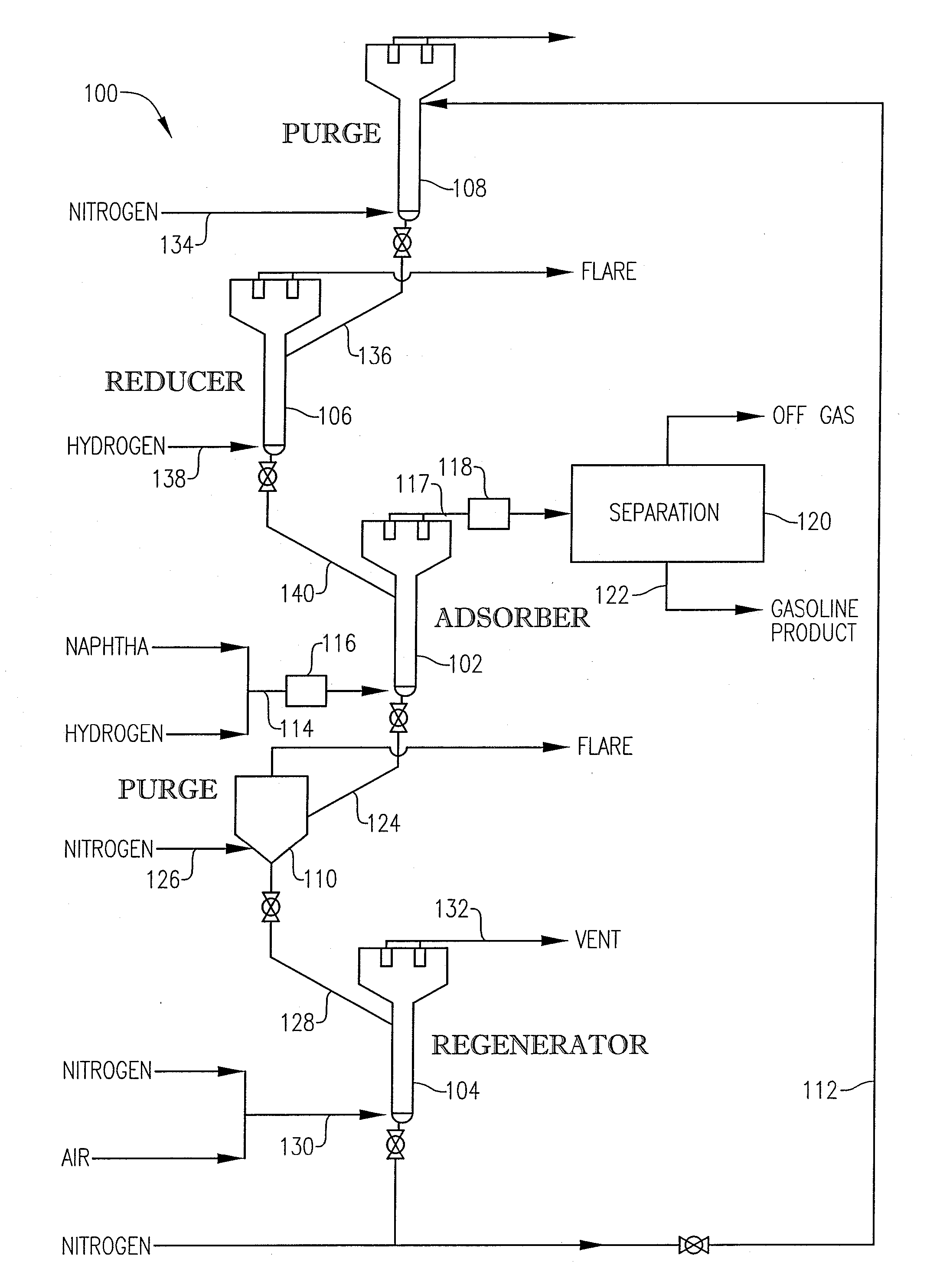Desulfurization With Octane Enhancement
a technology of desulfurization and octane, which is applied in the direction of physical/chemical process catalysts, other chemical processes, non-metal refining, etc., can solve the problems of reducing the octane number undesirable high levels of sulfur in such automotive fuels, etc., to achieve easy circulation, minimize octane loss, and enhance the octane of the resulting desulfurized fluid stream
- Summary
- Abstract
- Description
- Claims
- Application Information
AI Technical Summary
Benefits of technology
Problems solved by technology
Method used
Image
Examples
example 1
(Comparative)
[0059] In this example, the above-described pilot plant 100 was used to conduct three comparative desulfurization runs (Runs 1-3) using only the base sorbent. Comparative Run 1 was performed at an adsorber temperature of 775° F. Comparative Run 2 was performed at an adsorber temperature of 800° F. Comparative Run 3 was performed at an adsorber temperature of 825° F. Table 6 shows the results for Comparative Runs 1, 2, and 3.
TABLE 6Base Sorbent Only:Run #123Temperature (F.)775800825Product Sulfur (ppmw)35.8045.1063.10Octane Loss0.570.09−0.20Net C3 − (wt %)0.100.180.20Net C4 − (wt %)0.190.300.50H2 Consumption (calc) (scf / bbl)56.8041.5043.90Delta Reid Vapor Pressure (RVP)−0.030.03−0.10Feed API52.0951.7451.74Feed RVP5.355.245.24Feed Specific Gravity (SG)0.770.770.77Product API52.7252.3251.98Product RVP5.325.275.14Product SG0.770.770.77Vol % Loss0.000.000.36% Vol Retained100.00100.0099.64
example 2
(5% High Activity)
[0060] In this example, three test runs (Runs 4-6) were performed with 5 weight percent of the High Activity Catalyst being added to the base sorbent system. Test Runs 4, 5, and 6 were conducted at adsorber temperatures of 775° F., 800° F., and 825° F., respectively. Table 7 shows the results for Test Runs 4, 5, and 6, as well as Comparative Runs 1, 2 and 3 which were conducted at the same temperatures.
TABLE 7Sorbent + 5 wt %Base Sorbent Only:Hi Activity Catalyst:Run #123456Temp (F.)775800825775800825Prod Sulfur (ppmw)35.8045.1063.1036.4047.2058.20Octane Loss0.570.09−0.20−0.69−1.10−1.25Delta Octane (from Base)1.261.191.05Net C3- (wt %)0.100.180.201.401.662.10Net C4- (wt %)0.190.300.503.654.315.40H2 Consump (calc) (scf / bbl)56.8041.5043.9077.1057.6058.00Delta RVP−0.030.03−0.100.400.690.93Feed API52.0951.7451.7452.5251.9852.32Feed RVP5.355.245.245.415.245.33Feed SG0.770.770.770.770.770.77Product API52.7252.3251.9854.0154.2255.17Product RVP5.325.275.145.815.936.26P...
example 3
(10% High Activity)
[0061] In this Example, two Test Runs (7 and 8) were performed with 10 weight percent of the High Activity Catalyst being added to the base sorbent system. Test Runs 7 and 8 were performed at adsorber temperatures of 775° F. and 825° F. Table 8 shows the results for Test Runs 7 and 8, as well as Comparative Runs 1 and 3 which were conducted at the same temperatures.
TABLE 8Sorbent + 10 wt %Base Sorbent Only:Hi Activity Catalyst:Run #1378Temp (F.)775825775825Prod Sulfur (ppmw)35.8063.1040.0065.50Octane Loss0.57−0.20−0.76−1.48Delta Octane (from Base)1.331.28Net C3 − (wt %)0.100.201.602.60Net C4 − (wt %)0.190.503.806.40H2 Consump (calc) (scf / bbl)56.8043.9071.8045.90Delta RVP−0.03−0.100.500.97Feed API52.0951.7452.2452.22Feed RVP5.355.245.275.29Feed SG0.770.770.770.77Product API52.7251.9853.9654.79Product RVP5.325.145.776.26Product SG0.770.770.760.76Vol % Loss0.000.362.905.09% Vol Retained100.0099.6497.1094.91% Vol Retained × Delta Octane129.14121.48% Vol Loss per O...
PUM
| Property | Measurement | Unit |
|---|---|---|
| mean particle sizes | aaaaa | aaaaa |
| weight ratio | aaaaa | aaaaa |
| weight percent | aaaaa | aaaaa |
Abstract
Description
Claims
Application Information
 Login to View More
Login to View More - R&D
- Intellectual Property
- Life Sciences
- Materials
- Tech Scout
- Unparalleled Data Quality
- Higher Quality Content
- 60% Fewer Hallucinations
Browse by: Latest US Patents, China's latest patents, Technical Efficacy Thesaurus, Application Domain, Technology Topic, Popular Technical Reports.
© 2025 PatSnap. All rights reserved.Legal|Privacy policy|Modern Slavery Act Transparency Statement|Sitemap|About US| Contact US: help@patsnap.com



